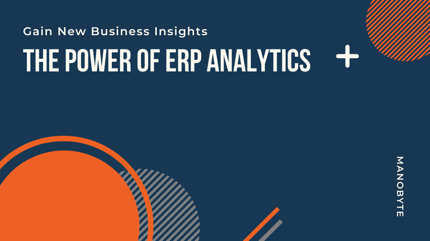
At one time, merely having an Enterprise Resource Planning tool was revolutionary. ERP software streamlines operations across departments so that each team and individual involved works together efficiently through enhanced communications, logistics, customer relationship management (CRM), and centralization of resources.
But times have changed, and companies are recognizing that it's not enough to unify operations; you need advanced analytics to optimize, and third party solutions often fall short. For this reason, more and more ERPs are beginning to fully integrate analytics with impressive results.
1. MODERN CLOUD ERP PROVIDES BUSINESS INTELLIGENCE
Today's more advanced ERPs do not just help you collect endless data, since data alone is not the answer. A Forrester study found that over 73% of data goes unused. Instead, ERPs with built-in analytics facilitate business intelligence (BI), which involves leveraging the data collected by your company to anticipate changes in areas like:
- Customer preferences
- Industry trends
- Supply chain
Through business intelligence, leaders more confidently guide the direction of an organization. Integrated ERP analytics allows you to dig deep into the data and strike golden nuggets of insight that are both timely and actionable.
2. ERP SOFTWARE DELIVERS REAL-TIME INSIGHT
Around 70% of businesses say they're investing more in real-time analytics, and 58% say that, as a result, they've significantly impacted customer retention. Forty-four percent say customer acquisition and revenues have risen. Understanding what already happened through analytics is useful, but it will only take you so far. You need data and insights to be as current as possible, and this is only possible through a cloud ERP with native analytics. This allows you to View employee and unit productivity as well as KPIs in real-time to adapt quickly to changing circumstances across departments. When you can track inventory, production, sales, and more all in real-time, you can make decisions quickly rather than taking time to make sense of the data., Not only that, you can achieve tangible benefits, as we'll explore next.
3. REALLOCATING RESOURCES
When Department A places a request to add full-time equivalent, or FTEs, to manage a growing customer base, integrated cloud ERP analytics can help you answer some critical questions.
- Are current human resources being utilized most effectively?
- How many FTEs do they actually need?
- Are FTEs underutilized elsewhere who can shift to this department?
- How might changes in process flow and technology influence productivity and reduce the need for more FTEs?
You can apply the above to almost any type of resource within your organization. ERP analytics helps you cut the waste within your company and get the most out of every resource.
4. DELIGHTING CUSTOMERS
Through ERP software analytics, you can see the customer journey from start to finish in ways you cannot achieve with a customer relationship management (CRM) alone. A comprehensive ERP with analytics uncovers the areas your customers see that are typically hidden from you--in other words, blind spots.
Through the power of cloud ERP analytics, you can turn the customer experience into a completely personalized experience in areas like:
- Optimization of customer-facing workflows
- Delivery coordination
- Education
- Issue resolution
- Returns and exchanges
- Recommendations
- Support and needs anticipation
- Interconnecting the journey
- Helping you and customer achieve maximum value out of the customer-brand relationship
- Adding automation where it matters most
5. MAXIMIZING PRODUCTIVITY
When analytics encompasses the entire operation, you can more easily see where employees are in positions to "hurry up and wait" because of unanticipated delays. You can measure productivity more objectively and fairly, and when you do this, your highly productive employees actually get more productive because now they see that you recognize their productivity and contribution to the success of the organization, which leads us to morale.
6. IMPROVING MORALE
Most business leaders know that morale and workplace culture are strongly linked to business success because when morale goes up, people feel engaged in your organizational success rather than feeling like pawns in your game. To this effect, a Gallup poll found that employers with engaged employees are 21% more profitable in part because of 41% less absenteeism and 59% drop in turnover. That is good for employees and great for customers and your organization.
ERP analytics impact morale in a direct fashion by keeping you in the know and helping you demonstrate to employees that leadership sees the challenges employees face in the various departments, and management is actively working to improve operations in a collaborative, cross-departmental way. The opposite of this is what you may see in many organizations, where challenges get reported and go unresolved, leaving employees feeling defeated and, even worse, inventing error-prone workarounds to make the best of a bad situation.
7. THE RIGHT FUEL FOR THE GROWTH
From risk management to the direction of the company, ERP software predictive analytics gives an organization the power to develop a data-driven strategy to greet the future of both challenges and possibilities, and fuel growth. Knowing that you're seeing the whole picture and can better anticipate how changes will impact customers, departments, vendors, and other stakeholders. Analytics-enabled cloud ERP software keeps the guesswork and speculation out of essential strategy meetings, as you actually have the data you need to make even the toughest of decisions.
EXPERIENCE THE POWER OF ERP ANALYTICS
ERP analytics can propel an organization through business intelligence to streamline operations, empower employees, and delight customers. The next step is to explore the power of ERP software for yourself. Let's connect to discuss your enterprise resource planning needs and goals.

